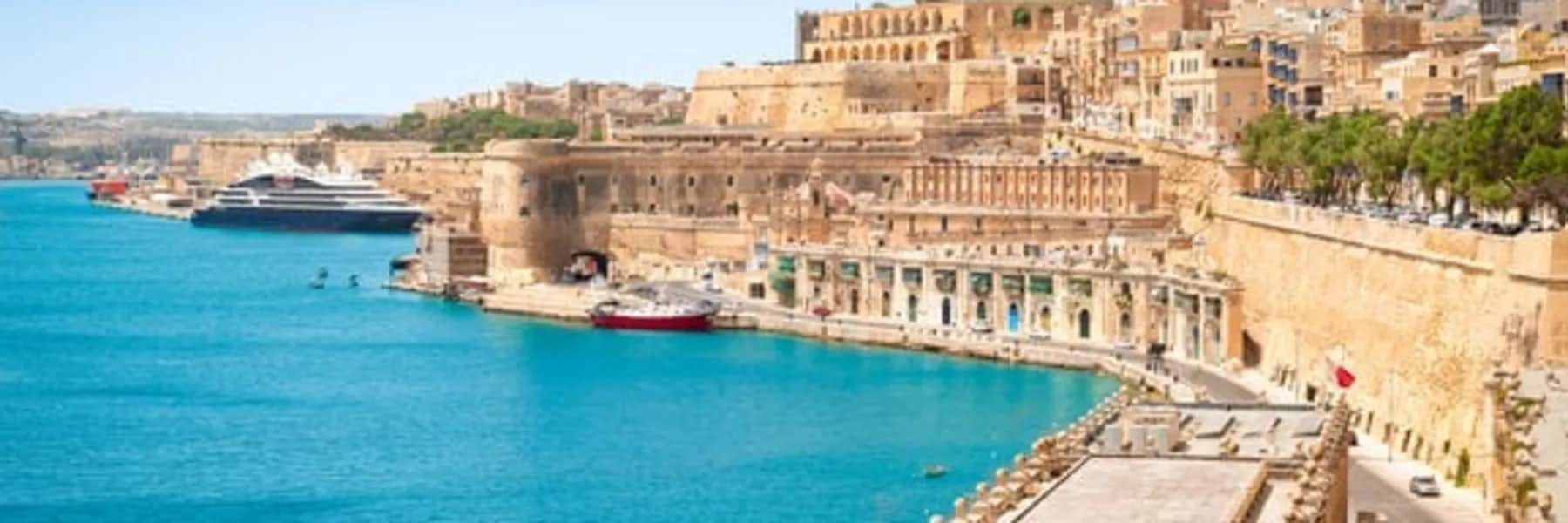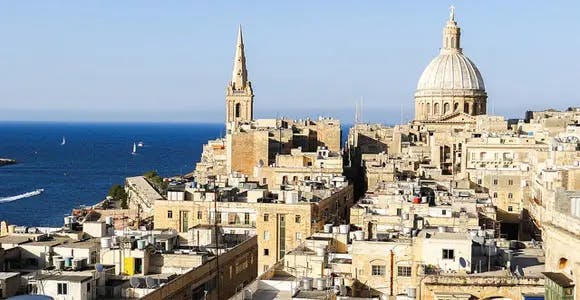Europe’s Smallest & Sunniest Capital
Most Europhiles are unaware that Valletta—the enchanting Mediterranean capital of Malta—is one of the first planned cities in Europe, designed and constructed by the Knights Hospitaller in the 16th century.
Military architect Francesco Laparelli led the team of Knights who envisioned a fortified city to serve as a bastion against the many invaders Malta has experienced throughout its history. The city’s layout was carefully planned in a grid pattern, allowing for efficient organization and defense strategies from every angle of the peninsula on which it is built.
Valletta possesses stunning architecture, strategic palisades around the seafront, and, to this day, well organized, easy-to-follow grid streets—albeit hilly and narrow. If you arrive to the city by sea—entering via one of the deepest natural harbors in Europe—the fortifications are quite imposing. It feels as if you are stepping back in time, looking up at the monochromatic limestone walls and buildings punctuated by a myriad of bright accent colors on the doors and iconic Maltese balconies.
Malta was a Crown Colony of the United Kingdom from 1814 until 1964 and part of the British Commonwealth after that, until finally emerging as a republic in 1974. You can still see the remnants of their history, such as driving on the left, three-pronged square electrical plugs, the parliamentary and education systems, English as an official language, and the iconic red phone and postal boxes.
The population of the Maltese islands is approximately 512,000, and Valletta’s current population is just under 6000 residents. Thus earning the title of Europe’s smallest capital.
Traveling to Valletta
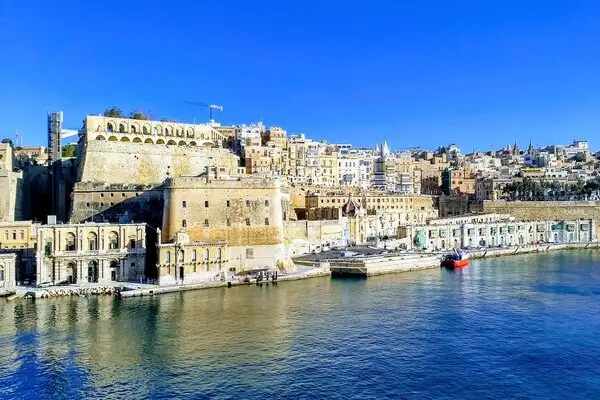
The best time to visit Valletta—and the rest of Malta—is during Europe’s Spring (April-June) or Fall (September-early November). Winter tends to be cool, damp, and windy (with highs struggling to get out of the 50s F and lows in the 40s F), while summer can get extraordinarily hot (with daytime highs soaring into the high 90s F). If you don’t mind the heat, summer can be a thrilling time on the islands. Malta experiences, on average, 300 days of sunshine per year, thus giving Valletta the title of the sunniest capital in the EU.
There are no nonstop flights from the Americas to Malta, so at least one connection is required. Malta has one airport, Luqa, located in the south-central part of Malta’s main island. Easy connections include British Airways through London, Lufthansa through Frankfurt or Munich, Air France through Paris, Turkish Air through Istanbul, ITA through Rome, or Swiss Air through Zurich. Other direct destinations are served by Europe’s low-cost carriers, such as Ryan Air, Easy Jet, Wizz Air, and Malta’s flagship airline, Air Malta (which will be folding at the end of 2023 and rebranding as a new airline TBD).
Because the island is so small, it’s a quick trip to Valletta upon arrival. With a normal traffic flow, it takes about 15 to 20 minutes to reach the airport. App-based cars (Bolt, eCabs, Uber) are waiting at the airport. And it will typically cost less than €20. The airport has car rentals on site, if you choose to drive. Prices for a compact car start as low as €60 weekly (remember to keep left). Or you can take the Malta Transport bus. Although significantly cheaper at just €2, it could take up to three times as long.
There are daily ferries from Sicily to Valletta. This stunning, fortified city has also become a high-demand cruise destination. Valletta currently handles approximately one million cruise passengers annually, with a cruise port offering seven berths—four of which are a 15-minute walk to the city center. Well known lines such as Seabourn, Oceana, Norwegian, Costa, MSC, and Celebrity all make Valletta a port of call. When you ask Mediterranean cruisers and crew their favorite port to enter, often they’ll say, “Valletta, Malta.”
Retire in Valletta
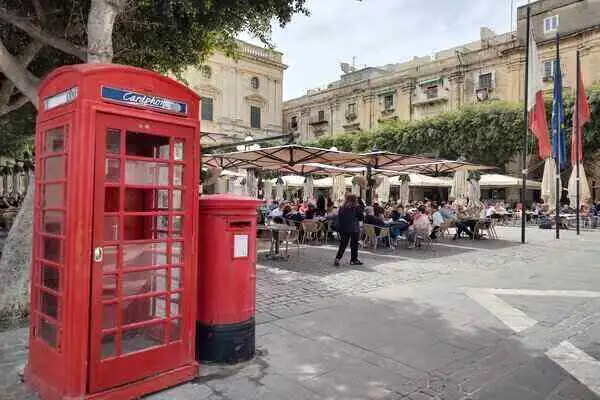
Valletta is a city rich in expats, including part-time investors and digital nomads, from nations around the world. Primarily British and other Europeans, but you find people from every corner of the earth. This melting pot of expat cultures and tourists makes for an easy assimilation to the city. Plus, English as an official language eases any angst for accomplishing business, joining social activities, and enjoying day-to-day life. The common language is English across the expat and interacting with the local community (even as a second or third language), since expats typically don’t speak Maltese.
There is no “bad” location to live on these charming islands, but Valletta is a popular choice for some, since it is the capital. It’s loaded with historical significance and is architecturally impressive. You don’t need a car because the city is so small and compact at approximately .24 square miles (.61 square kilometers). Therefore, everything within Valletta is accessible by foot. But beware, you will want good walking shoes. It’s not a city recommended for those with mobility challenges due to small, uneven pavements.
Since Valletta is located on a peninsula, there are ferries or water taxis to the “suburbs”—south to the historical 3 Cities or north to Sliema and St. Julians, where you will find shopping, nightlife, and most of the expat population reside. The ferries depart regularly throughout the year and those residents age 60+ holding a Tallinja (Malta Public Transport) card can ride round trip for just €0.90 or €0.50 one way. The public bus system's main terminus is just outside the city gate of Valletta, making it an easy journey to anywhere on the main island of Malta. 60+ residents can ride the bus for free.
Because Valletta is a small, antiquated, walled city built hundreds of years ago, you will not find any stand-alone homes in North American-style buildings. It is basically a massive fortress without any extra land to build anything new. There are mansions and villas tucked behind walls and Maltese balconies, however the price tags are typically well into the multi-digit millions. And many of the properties, in Valletta especially, are passed down through the Maltese generations. As an outsider, finding the right place to live becomes a challenge. But not impossible!
Christine Kelly and her partner, Norbert Horvath, moved to Valletta from Toronto, Ontario, in January 2021 and are renting while renovating a recently purchased home. “We like the buzz of living in the capital city. Even in the winter, it's a bustling place with a great selection of cultural activities and amazing restaurants. Plus, the architecture is beautiful, and the people are friendly and welcoming. It's also very easy to get to everywhere else on the island by bus or Bolt or ferry from Valletta,” she explained.
Christine shares her experience of house hunting in this lovely city, “We worked with a local agent for about six months, and looked around lots of apartments and houses. We categorically told the agent we did not want a big renovation project, but when we looked round the place we liked, we were blown away by its potential. We were also slightly disappointed by the homes we found that were already renovated. We plan to stay in Malta indefinitely so we decided to bite the bullet and try to build exactly what we wanted rather than compromise and buy something not really what we were looking for.
That said, it hasn’t been a very straightforward process so far. Completing the sale took over nine months. Searches are incredibly complex in Valletta because the lawyers have to search through ownership details scanning back over centuries for a property, and most properties are not single-unit standalone homes—they’re all jumbled up with rooms hanging over neighbor’s properties and different floors belonging to different families, for example.”
She continues, “We finally completed the purchase in Oct 2022 and since then have been working with local architects to draw up plans and obtain planning permission. It's been a very complex process because Valletta is a UNESCO World Heritage Site and is protected on the Maltese national level by an Antiquities Protection Act of 1925. Once we have permission finalized, construction can begin. Again, this is complicated because traditional methods must be used, which comply with the heritage regulations. We anticipate it taking approximately 18 - 24 months. Fortunately, the architects we are working with are excellent, and have been guiding us through the process.”
There are no Special Designated Areas (SDA’s) in Valletta. SDAs are large developments built in other parts of the country especially for foreigners who can purchase property in Malta with the same acquisition rights as Maltese citizens within those developments. Therefore, buying in Valletta will take an extra step to attain an AIP permit (Acquisition of Immovable Property).
There are a number of visa options, including the digital nomad visa or a work visa if you are, for example, working for many of the I-gaming companies located on the island. If you are a retired third country national (non-EU), you can apply for permanent residency through the Malta Permanent Residency Programme (MPRP). Or as a part-time expat, Canadians and US citizens can stay in Malta and the EU Schengen region for 90 days without a visa or up to 180 days per year (90 days in/90 days out).
For health needs there is a clinic and a dental clinic, as well as several pharmacies in Valletta. The top private hospital (St. James Capula) is located in Sliema, and the best public hospital (Mater Dei) is in L-Imsida. Driving distance to each is approximately 15-20 minutes from Valletta.
Lifestyle in Valletta
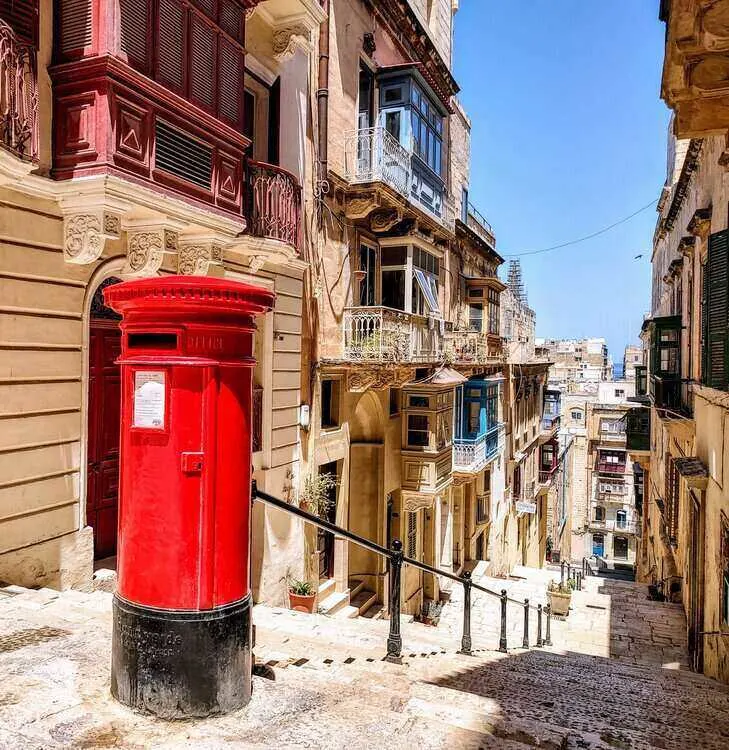
The lifestyle in Valletta can be fast-paced and vibrant, especially when the cruise ships arrive into port and the tourists pour into the city. And you will never tire of exploring the city's incredible history and architecture and surrounding areas.
You don’t really need a car in Valletta. There is a larger grocery store in the middle of town and several smaller shops. If you need something more specialized, you can take the city bus or a Bolt—which are both inexpensive and a great way to stock up on supplies not available just around the corner.
Valletta—like all of Malta—is one of the safest places in the world. You will not hear about mass shootings, armed robberies, or gang turf homicides. They simply don’t happen in Malta. One can walk down the streets alone safely after dark. However, it’s always good to exercise caution as, on rare occasions, you will hear about petty theft or bag snatching—especially late at night in some of the entertainment areas like Straight Street or crowded tourist sites.
If you’re into boating, sailing, diving, water sports, etc. Valletta is surrounded by water and is situated on the Grand Harbour—so it is pretty easy to find what you are looking for. And if you golf, it is just a 15-minute drive to Malta’s Royal Golf course. Nature hikes, however, will take a little more travel time, as Valletta is unequivocally not a “natural” destination.
Because Malta is so small, 124 mi² (320 km²) and a total coastline of 122.4 mi (197km), it is easy to make a day trip from Valletta to anywhere on the island and even the neighboring islands of Gozo and Comino.
Things to Do in Valletta
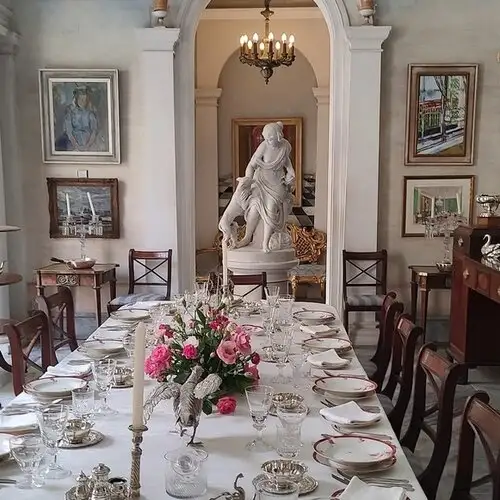
Casa Rocca Piccola.
Valletta is one of the most concentrated areas of historical significance—with more centuries-old ruins, buildings, churches, fortresses, cathedrals, and ancient palaces than you can imagine.
One of the top sites in Valletta includes St. John’s Co-Cathedral, with its opulent Baroque interior and its history dating back to the Knights of Malta.
Also recommended is the only palace in Valletta which is still inhabited. The owner of the 16th-century Casa Rocca Piccola Palace has opened 12 of the 50 rooms for tours and houses a massive collection of paintings, silver, and superbly crafted antique furniture.
The Maltese National Theatre, or the Teatru Manoel, was built in 1731 to entertain the knights and general population. It is one of the oldest theaters in Europe and is still open for performances and tours. Baroque in its style, the golden chandelier within is quite impressive.
The saluting battery (the oldest still operating in the world) in the Upper Barrakkara Gardens towering over the Grand Harbour offers breathtaking views from a beautiful park. The cannons are fired at noon and 4pm daily.
The immense Fort St. Elmo and the National War Museum educate on the history of invasions of Malta. Fort St. Elmo was built in 1552 by the knights to protect Valletta. The fort also played an important role as a major defense structure when the Italians bombed Malta in WWII. If you are a history buff, put it on your list.
Take a cruise around the waterfront and see Valletta’s magnificence from the sea. Just across the Grand Harbour on the south side, a 10-minute ferry ride will take you to Vittoriosa, Senglea, and Cospicua, known as the Three Cities and considered the cradle of Maltese History.
Cost of Living
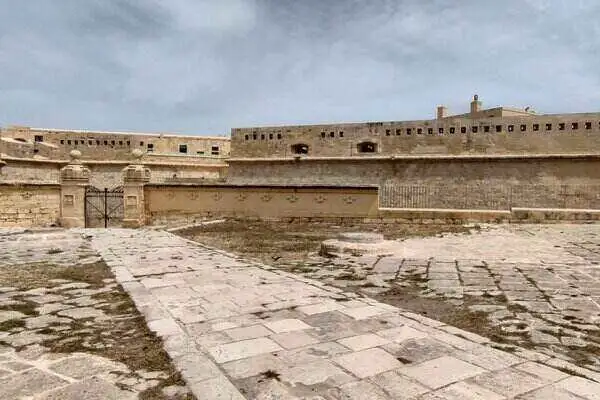
Fort St. Elmo.
Malta is part of the EU trade agreement. That means that products imported from other EU countries are not subject to tariffs imposed from other places—helping to keep costs low. Lower than most places in North America. You will find dinners out and entertainment to clothing and healthcare to cost less, as well as the overall cost of living.
However, Valletta is one of the most expensive places on the island as far as real estate prices and rentals. Mostly on par with some of the typical homes and condos you will find in trendy cities in the Americas. But there is always a gem to be uncovered.
I found a two-bedroom, one-bathroom for sale, just a corner around from the seafront in an old historic building built in the 1930s. The asking price is €329,000. Although it has sizable rooms, high ceilings, and good bones, it is unquestionably a place one would call a fixer-upper. Prices for more liveable properties will range from €475,000 to €1,500,000+ and rentals from €1,000 to €6,000. So, it is still possible to live in this Mediterranean capital city for $3000 or less.
Here is a sample lower-end budget for monthly expenses for a couple living in Valletta. Of course, your lifestyle and housing requirements can vary widely.
| Expense | US $ |
| Rent (furnished, two-bedroom apartment/home) | $1,200 |
| Electricity | $120 |
| Water | $10 |
| Household help (weekly maid) | $140 |
| Internet | $30 |
| Cellphone | $10 |
| Cable/Pay TV | $50 |
| Healthcare (for two people) | $350 |
| Transportation | $50 |
| Groceries | $600 |
| Entertainment | $250 |
| Miscellaneous | $100 |
| Monthly Total: | $2,910 |
If living a vibrant lifestyle in a small historical walled city with unparalleled sea views is of interest for retirement or investment, add Valletta, Malta, to your must-see list.
